NGF controls dendrite development in hippocampal neurons by binding to p75NTR and modulating the cellular targets of Notch
- PMID: 15496460
- PMCID: PMC539177
- DOI: 10.1091/mbc.e04-05-0438
NGF controls dendrite development in hippocampal neurons by binding to p75NTR and modulating the cellular targets of Notch
Abstract
Notch and neurotrophins control neuronal shape, but it is not known whether their signaling pathways intersect. Here we report results from hippocampal neuronal cultures that are in support of this possibility. We found that low cell density or blockade of Notch signaling by a soluble Delta-Fc ligand decreased the mRNA levels of the nuclear targets of Notch, the homologues of enhancer-of-split 1 and 5 (Hes1/5). This effect was associated with enhanced sprouting of new dendrites or dendrite branches. In contrast, high cell density or exposure of low-density cultures to NGF increased the Hes1/5 mRNA, reduced the number of primary dendrites and promoted dendrite elongation. The NGF effects on both Hes1/5 expression and dendrite morphology were prevented by p75-antibody (a p75NTR-blocking antibody) or transfection with enhancer-of-split 6 (Hes6), a condition known to suppress Hes activity. Nuclear translocation of NF-kappaB was identified as a link between p75NTR and Hes1/5 because it was required for the up-regulation of these two genes. The convergence of the Notch and p75NTR signaling pathways at the level of Hes1/5 illuminates an unexpected mechanism through which a diffusible factor (NGF) could regulate dendrite growth when cell-cell interaction via Notch is not in action.
Figures

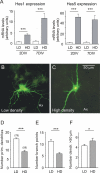
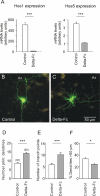
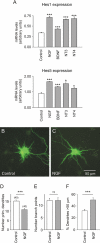
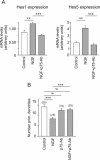
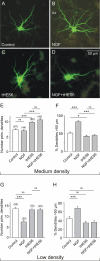
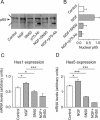

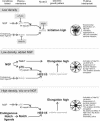
Similar articles
-
Notch and NGF/p75NTR control dendrite morphology and the balance of excitatory/inhibitory synaptic input to hippocampal neurones through Neurogenin 3.J Neurochem. 2006 Jun;97(5):1269-78. doi: 10.1111/j.1471-4159.2006.03783.x. Epub 2006 Mar 15. J Neurochem. 2006. PMID: 16539652
-
NGF-activated protein tyrosine phosphatase 1B mediates the phosphorylation and degradation of I-kappa-Balpha coupled to NF-kappa-B activation, thereby controlling dendrite morphology.Mol Cell Neurosci. 2010 Apr;43(4):384-93. doi: 10.1016/j.mcn.2010.01.005. Epub 2010 Feb 1. Mol Cell Neurosci. 2010. PMID: 20123020
-
Regulation of hippocampal neuronal differentiation by the basic helix-loop-helix transcription factors HES-1 and MASH-1.J Neurosci Res. 1999 May 1;56(3):229-40. doi: 10.1002/(SICI)1097-4547(19990501)56:3<229::AID-JNR2>3.0.CO;2-Z. J Neurosci Res. 1999. PMID: 10336252
-
[Abnormal Notch-Hes Signaling Pathways and Acute Leukemia -Review].Zhongguo Shi Yan Xue Ye Xue Za Zhi. 2017 Feb;25(1):240-243. doi: 10.7534/j.issn.1009-2137.2017.01.043. Zhongguo Shi Yan Xue Ye Xue Za Zhi. 2017. PMID: 28245409 Review. Chinese.
-
Transcription factors in dendrites: dendritic imprinting of the cellular nucleus.Results Probl Cell Differ. 2001;34:57-68. doi: 10.1007/978-3-540-40025-7_4. Results Probl Cell Differ. 2001. PMID: 11288679 Review. No abstract available.
Cited by
-
Hes1 in malignant tumors: from molecular mechanism to therapeutic potential.Front Immunol. 2025 Jul 18;16:1585624. doi: 10.3389/fimmu.2025.1585624. eCollection 2025. Front Immunol. 2025. PMID: 40755759 Free PMC article. Review.
-
CC2D1A regulates human intellectual and social function as well as NF-κB signaling homeostasis.Cell Rep. 2014 Aug 7;8(3):647-55. doi: 10.1016/j.celrep.2014.06.039. Epub 2014 Jul 24. Cell Rep. 2014. PMID: 25066123 Free PMC article.
-
BMP7-induced dendritic growth in sympathetic neurons requires p75(NTR) signaling.Dev Neurobiol. 2016 Sep;76(9):1003-13. doi: 10.1002/dneu.22371. Epub 2016 Jan 22. Dev Neurobiol. 2016. PMID: 26663679 Free PMC article.
-
Notch signaling and neural connectivity.Curr Opin Genet Dev. 2012 Aug;22(4):339-46. doi: 10.1016/j.gde.2012.04.003. Epub 2012 May 17. Curr Opin Genet Dev. 2012. PMID: 22608692 Free PMC article. Review.
-
HES5 silencing is an early and recurrent change in prostate tumourigenesis.Endocr Relat Cancer. 2015 Apr;22(2):131-44. doi: 10.1530/ERC-14-0454. Epub 2015 Jan 5. Endocr Relat Cancer. 2015. PMID: 25560400 Free PMC article.
References
-
- Aibel, L., Martin-Zanca, D., Perez, P., and Chao, M. V. (1998). Functional expression of TrkA receptors in hippocampal neurons. J. Neurosci. Res. 54, 424-431. - PubMed
-
- Bae, S., Bessho, Y., Hojo, M., and Kageyama, R. (2000). The bHLH gene Hes6, an inhibitor of Hes1, promotes neuronal differentiation. Development 127, 2933-2943. - PubMed
-
- Baker, R. E., Dijkhuizen, P. A., Van Pelt, J., and Verhaagen, J. (1998). Growth of pyramidal, but not non-pyramidal, dendrites in long-term organotypic explants of neonatal rat neocortex chronically exposed to neurotrophin-3. Eur. J. Neurosci. 10, 1037-1044. - PubMed
Publication types
MeSH terms
Substances
LinkOut - more resources
Full Text Sources
Molecular Biology Databases
Research Materials

